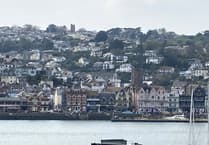Fresh calls have been made to improve the pollution on a busy Totnes road, following the publication of a new report which highlights the serious long term health risks associated with exposure to traffic emissions.
Local county and district councillor, Jacqi Hodgson, is calling on both councils to take urgent action to clean up the air quality of the A385, which runs past King Edward VI Community College, to protect the health of residents and school children.
The arterial route that passes through the town is at the heart of a South Hams Air Quality Management Area (AQMA) declared more than a decade ago due to poor levels of Nitrogen Dioxide (NO2) in breach of national levels and caused by excessive traffic.
A new report that has been published by Imperial College London, sets out a series of health impacts caused by exposure to traffic emissions.
The report, commissioned by the Greater London Authority shows that “air pollution causes harm at all stages of life.”
It says exposure to certain particle could lead to low birth weight and miscarriages, cause low sperm count and asthma, stunt children’s lung growth, and have an adverse effect on blood pressure, cognitive abilities and mental health. In adulthood it could cause chronic illnesses, cancer and strokes.
The team from Imperial’s Environmental Research Group looked at evidence from more than 35,000 studies over 10 years.
Cllr Hodgson said: “The researchers lay the blame for these health risks on particulate matter, known as PM2.5, and nitrous dioxide as being particularly harmful toxins.
“In particular, they confirmed previous reports issued by the World Health Organisation a couple of years ago that there is no safe level of particulate matter PM2.5.
“PM2.5 comes from vehicle tyres as well as exhausts and is known to be particularly high along roads frequented by large diesel vehicles and lorries.”
Despite these findings, calls to both the county and district councils to take action by creating safer pedestrian routes and providing more public transport services such as electric buses, have come to “almost nothing,” Cllr Hodgson said.
“Over the years there have been many carefully thought out schemes put to SHDC and DCC that could make a difference to how people travel around and through Totnes, that could dramatically reduce the traffic in the town centre, and the through traffic and its toxic fumes,” she said.
“Sadly the proposals to install a pedestrian crossing on the lower side of the traffic lights at the Plymouth Road and Western by-pass junction was responded to by DCC saying this would increase emissions as traffic would have to wait longer while people crossed the road, so no improvements have been carried out.
“Similarly, proposals to implement the 20’s Plenty speed campaign where people live and work could make streets safer to walk and cycle, enabling people to drive less.
“Cornwall is rolling this out across the county, while Devon is accepting applications at a rate of about four small areas a year.
“These simple measures could dramatically reduce these dangerous emissions. National incentives such as more widespread public buses and requiring freight to be transferred from road to rail are all possible.”
Cllr Hodgson says both the district and county councils have jointly created an action plan to address the emissions on the A385, but the plan has not made any difference to the pollution levels.
She is also alarmed that new housing developments along the A385 have recently received the green light, as she fears they will lead to even more toxic emissions on the road, Cllr Hodgson said.
She insisted: “This new report shows just how serious this is.
“It’s about time the powers that be acknowledged their legal responsibilities and took heed of this important research, and took real and urgent action to clean up the air we breathe and protect the health of our residents.”
Devon County and South Hams Councils have been approached for comment.




